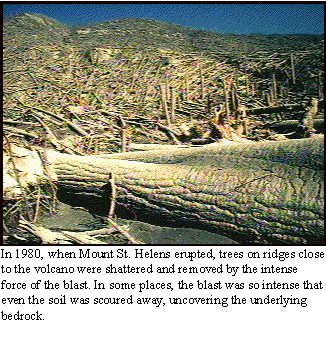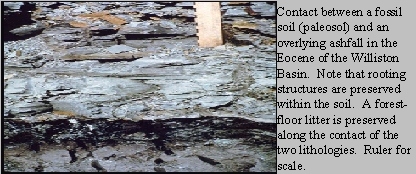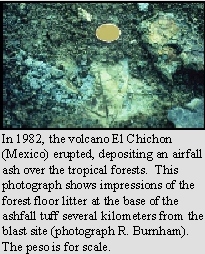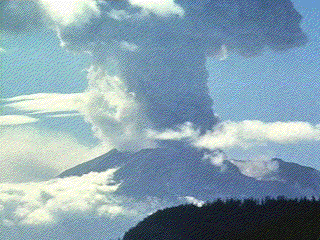
Plants and plant parts may be preserved within either:
An excellent preservation potential for trees, logs, and stumps exists in coarse-grained volcaniclastic sediments. The best potential for preservation exists when significant quantities of ash are generated burying the local vegetation.

Depending upon the distance from the blast site, trees subjected to blasts, surges, and debris avalanches may be:

Trees may be transported as logs (oriented to flow with basal end upstream) and erect stumps.
| Criteria to distinguish transported upright stumps from in situ upright stumps in volcaniclastic terrains (after Fritz & Harrison, 1983). | ||
| FACTOR | TRANSPORTED | IN SITU |
| Trunk:Root ratio | <1 | >1 |
| Large Roots | Broken | Intact |
| Small Roots | Intact | Intact |
| Roots Entwine Boulders | Yes, small ones | Yes |
| % Vertical Stumps | <10% | >10% |
| Facies | Channel Fills | Fine-grained, Lacustrine, Floodplain |
| Soils | None | True Paleosol |
Low Velocity, highly viscous flows are the best medium for the transport of upright stumps.
High Velocity, highly fluid flows transport trees as horizontal logs or pulverize the vegetation into macrodetritus. Pyroclastic flows and ash-flow tuffs preserve mostly horizontal logs that have been burned to charcoal (fusain).

Leaf Assemblages in volcaniclastics present a variety of vegetational representations depending upon the position of the deposit relative to the eruptive vent.

 For More information about the Mount St. Helens Blast
For More information about the Mount St. Helens Blast